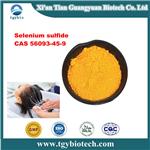The Role and Significance of Selenium Sulfide in Modern Chemistry
Jan 17,2025
Introduction
Selenium sulfide (SeS2 or Se=S) is a selenium salt. At room temperature, it is a yellow-orange tablet or powder. In contrast to the water-soluble selenium salts, selenium sulfide is insoluble in water and nontoxic when taken orally. Indeed, it is safe in animal studies and not carcinogenic when applied topically.

Clinical Uses
Selenium sulfide is a liquid antiseborrheic, antifungal preparation for topical application only. It is available by prescription only as a 2.5% lotion. The 1% selenium sulfide strength (Selsun Blue) is available over the counter. Selenium sulfide is currently indicated for treating pityriasis versicolor and seborrheic dermatitis of the scalp. In addition, some reports have shown that selenium sulfide is effective in treating confluent and reticulated papillomatosis of Gougerot and Carteaud. Selenium sulfide has also been shown to be an effective adjuvant with griseofulvin in treating tinea capitis. Selenium seems to have a cytostatic effect on epidermis cells and follicular epithelium cells. This property allows for the shedding of fungi in the stratum corneum via a reduction in corneocyte adhesion. Selenium sulfide has also shown some fungicidal activity against M. furfur in vitro and in vivo. Some previously considered selenium sulfide a possible carcinogen, but numerous studies have not confirmed this. However, animal reproductive studies have not been performed, and topical selenium is classified as pregnancy category C. Blood and urine levels of selenium are not increased by the topical courses recommended for treating tinea versicolor. Selenium sulfide 2.5% is effective in treating pityriasis versicolor and has shown efficacy similar to bifonazole in treating this condition.
Mechanism of action
Selenium sulfide interferes with hydrogen bond formation in the keratin and thus is keratolytic. It is keratoplastic and depresses the epidermal cell turnover rate. Selenium sulfide is fungicidal at higher concentrations.
Adverse effects
Selenium sulfide is drying and may be an irritant. It will also stain the coat, so it is not recommended as a first-line shampoo.
![]() References
References
[1]Cummins, Laurence M., and Eugene T. Kimura. "Safety evaluation of selenium sulfide antidandruff shampoos."Toxicology and applied pharmacology20.1 (1971): 89-96.
[2]Hageman, S. P. W., et al. "Microbial selenium sulfide reduction for selenium recovery from wastewater."Journal of hazardous materials329 (2017): 110-119.
- Related articles
- Related Qustion
Supplementation with pyridoxal 5'-phosphate monohydrate can synthesize neurotransmitters such as dopamine and serotonin, maintaining a healthy nervous system.....
Nov 4,2025Biochemical EngineeringN,N-Diethyl-3-methylbenzamide, commonly known as DEET, is one of the most widely used active ingredients in insect repellents.....
Dec 13,2024Chemical pesticides ?Selenium sulfide
56093-45-9You may like
Selenium sulfide manufacturers
- Selenium sulfide USP/EP/BP
-

- $1.10 / 1g
- 2025-11-18
- CAS:56093-45-9
- Min. Order: 1g
- Purity: 99.9%
- Supply Ability: 100 Tons Min
- Selenium sulfide
-

- $1286.00 / 1Kg
- 2024-10-06
- CAS:56093-45-9
- Min. Order: 0.100Kg
- Purity: 98
- Supply Ability: 500 Kg
- Selenium sulfide
-

- $80.00 / 1Kg/Bag
- 2024-09-18
- CAS:56093-45-9
- Min. Order: 1Kg/Bag
- Purity: 99%
- Supply Ability: 1500kg






